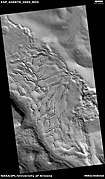Elysium Planitia
Elysium Planitia
Jump to navigation
Jump to search
 MOLA topographical map of Elysium Planitia. | |
| Coordinates | 3°00′N 154°42′E / 3.0°N 154.7°E / 3.0; 154.7Coordinates: 3°00′N 154°42′E / 3.0°N 154.7°E / 3.0; 154.7 |
|---|---|
Elysium Planitia, located in the Elysium and Aeolis quadrangles, is a broad plain that straddles the equator of Mars, centered at 3°00′N 154°42′E / 3.0°N 154.7°E / 3.0; 154.7.[1] It lies to the south of the volcanic province of Elysium, the second largest volcanic region on the planet, after Tharsis. Elysium contains the major volcanoes Elysium Mons, Albor Tholus and Hecates Tholus. Another more ancient shield volcano, Apollinaris Mons, is situated just to the south of eastern Elysium Planitia.
The largest craters in Elysium Planitia are Eddie, Lockyer, and Tombaugh. The planitia also has river valleys--one of which, Athabasca Valles may be one of the youngest on Mars. On the east side is an elongated depression called Orcus Patera.
A 2005 photo of a locale in Elysium Planitia at 5° N, 150° E by the Mars Express spacecraft shows what may be ash-covered water ice. The volume of ice is estimated to be 800 km (500 mi) by 900 km (560 mi) in size and 45 m (148 ft) deep, similar in size and depth to the North Sea.[2] The ice is thought to be the remains of water floods from the Cerberus Fossae fissures about 2 to 10 million years ago. The surface of the area is broken into 'plates' like broken ice floating on a lake. Impact crater counts show that the plates are up to 1 million years older than the gap material, showing that the area solidified much too slowly for the material to be basaltic lava.[3]
Contents
1 Exploration
2 Fractured ground
3 Mesas
4 Cones
5 Gallery
6 Interactive Mars map
7 See also
8 References
9 External links
Exploration[edit]
The InSight mission is expected to land on Elysium Planitia in November 2018.[4]
Fractured ground[edit]

Wide view of fractured ground, as seen by HiRISE under HiWish program

Close view of fractured ground, as seen by HiRISE under HiWish program

Close view of fractured ground, as seen by HiRISE under HiWish program Box shows size of football field. The boulders are the size of houses.

Close, color view of fractured ground, as seen by HiRISE under HiWish program
Mesas[edit]

Wide view of layered buttes and small mesas, as seen by HiRISE under HiWish program Some dark slope streaks are visible.

Layered mesa and mounds with dark slope streaks, as seen by HiRISE under HiWish program

Close view of layered small mesa with dark slope streak, as seen by HiRISE under HiWish program Box shows the size of a football field.

Very close view of individual blocks breaking off layer in a butte, as seen by HiRISE under HiWish program Blocks have angular shapes. Box shows size of football field.

Layered mesas, as seen by HiRISE under HiWish program

Layered mesas, as seen by HiRISE under HiWish program Dark slope streaks are also visible.

Mesas, as seen by HiRISE under HiWish program Top layer, the cap rock is breaking up into boulders.

Close view of cap rock breaking up into boulders, as seen by HiRISE under HiWish program
Cones[edit]

Cones, as seen by HiRISE under HiWish program These cones probably formed when hot lava flowed over ice-rich ground.

Close view of cones, as seen by HiRISE under HiWish program These cones probably formed when hot lava flowed over ice-rich ground.
Gallery[edit]

MOLA map showing boundaries of Elysium Planitia and other nearby regions.

Layers around streamlined knob, as seen by HiRISE under HiWish program.

Layers in old crater rim, in Marte Vallis as seen by HiRISE under HiWish program

Close view of layers from previous image, as seen by HiRISE under HiWish program Some dark slope streaks are visible.

Mounds with layers, as seen by HiRISE under HiWish program. Location is east of Gale Crater in the Aeolis quadrangle.

Mound showing layers at the base, as seen by HiRISE under HiWish program. Location is east of Gale Crater in the Aeolis quadrangle.

Yardangs showing layers, as seen by HiRISE under HiWish program. Location is east of Gale Crater in the Aeolis quadrangle.

Mesas and eroded parts of mesas showing layers and dark slope streaks, as seen by HiRISE under HiWish program. Image is located in eastern Avernus Colles.

Wide view of layered terrain, as seen by HiRISE under HiWish program Location is northeast of Gale Crater.

Close view of mound with layers, as seen by HiRISE under HiWish program Note: this is an enlargement from the previous image.

Close view of mound with layers, as seen by HiRISE under HiWish program Note: this is an enlargement from a previous image.

Wide view of layered terrain, as seen by HiRISE under HiWish program Note: parts of this image are enlarged in the next three images.

Close view of layers in a mound, from previous image, as seen by HiRISE under HiWish program

Close view of layers in a mound, from a previous image, as seen by HiRISE under HiWish program

Close view of layers in a mound, from a previous image, as seen by HiRISE under HiWish program

Lava field on Elysium Planitia resembling an elephant

Lava flow and dark slope streaks, as seen by HiRISE under HiWish program































